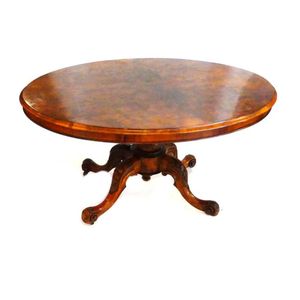Burr Walnut Oval Centre Table with Rococo Style Legs
A burr walnut oval shaped centre (or loo) table upon a central carved base and 4 rococo style legs with castors. 101 x 135 cm
You must be a subscriber, and be logged in to view price and dealer details.
Subscribe Now to view actual auction price for this item
When you subscribe, you have the option of setting the currency in which to display prices to $Au, $US, $NZ or Stg.
This item has been sold, and the description, image and price are for reference purposes only.
- Burr - Burr (or in the USA, burl) is the timber from the knotted roots or deformed branch of the tree, which when cut, displays the small circular knots in various gradations of colour. It is always cut into a decorative veneer, most commonly seen as burr walnut on 19th century furniture.
- Castors - Wheels, fitted especially to chair legs, couches, tables and some smaller pieces of furniture, to enable them to be easily moved about. The earliest castors were of brass, with shanks fitting into the base of the leg, and the wheels often made of leather. In the late 18th century, brass 'bucket' or 'cup' castors were introduced, either rounded or square, fitting directly over the end of the leg and held in place with screws. The wheels were generally solid brass. Bucket/cup castors continued in use throughout the 19th century and indeed are still made today. In the later 19th century wheels were sometimes made of wood, china, either white or brown, and sometimes of steel.
- Rococo - A stylistic development covering the period from about 1730 to 1770, during the reign of Louis XV in France. The rococo style falls between the rather overbearing manner of the Baroque and the formal elegance of Neoclassicism. The Rococo style reached its full maturity in France, though many of its features were used by English furniture makers. The style is marked by asymmetrical forms, especially pierced and intricate scroll work as in mirror frames, chair backs etc., and the use of shells and floral motifs. The term derives from the French 'rocaille', meaning rock work, as in gardens and fountains. There was a major Rococo revival in the mid-19th century and indeed much of what is now considered to be typically Victorian furniture is influenced by the Rococo. It is essentially feminine in feeling, and for this reason, perhaps, was regarded as rather frivolous by its successors.
This item has been included into following indexes:
